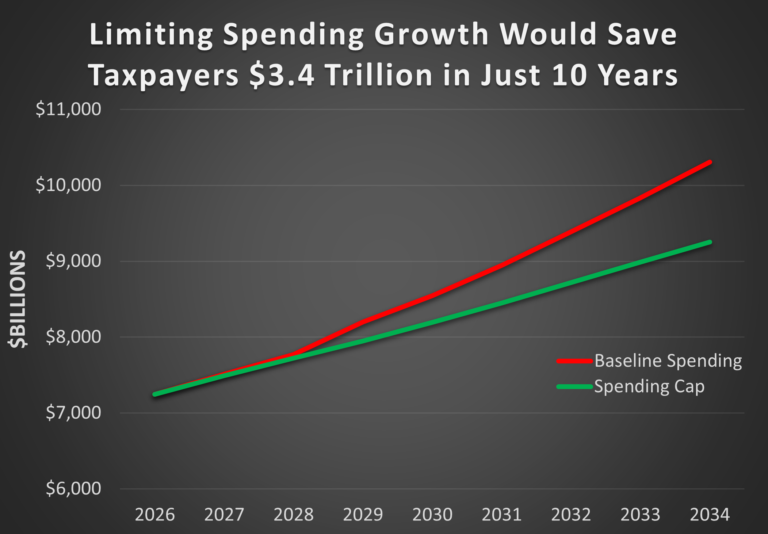During his first term, Donald Trump did not do a good job on government spending, writes Dan Mitchell.
Instead of draining the swamp, he expanded it. The most damning evidence is that he increased domestic spending at a faster rate than Barack Obama. And that’s not even counting the orgy of pandemic-related spending in his last year!
If he wants better performance in his second term, he should embrace a spending cap.
For instance, if there was a rule limiting spending to the combined rate of population plus inflation (like the very successful TABOR spending cap in Colorado), it would save taxpayers $3.4 trillion compared to how much the federal government would grow if left on autopilot.
This chart comes from a new study I wrote for the Center for Freedom and Prosperity. Co-authored with Robert O’Quinn, the former Chief Economist at the Department of Labor, it explains that a spending cap works much better than a balanced budget requirement.
The most effective budget reform that the United States could adopt to ensure its long-term prosperity is a spending cap. …Even if the economy is weak, nominal economic output will expand by an average of about 4 percent annually (meaning about 2 percent “real” GDP growth). And that means about 4 percent to 5 percent more tax revenue every year.It’s possible to slowly but surely control—and eventually shrink—the burden of federal spending if policymakers simply figure out some way to impose a spending cap so that outlays grow at a modest rate, say 2 percent annually. …The bad news is that few governments have imposed spending caps. The good news is that there have been very positive results when such policies are in effect. …In Switzerland, voters used a referendum in 2001 to impose the aforementioned debt brake, which operationally functions as a spending cap. Outlays have expanded by only about 2 percent annually since the constitutional reform was implemented. That restraint has led to a modest reduction in the burden of spending relative to GDP and a big reduction in government debt as a share of economic output.
The study cites research from international bureaucracies (such as the IMF, OECD, and ECB) showing that spending caps are the only effective fiscal rule.
Since I’ve already cited those reports (see here, here, here, here, here, and here), I won’t bother recycling that information. Suffice to say that it’s remarkable that even traditionally left-leaning, pro-tax international organizations agree with me.
For purposes of today’s column, however, the relevant issue is whether Donald Trump agrees.
One hopeful sign is that Elon Musk, a Trump confidante, wants to cut $2 trillion. As far as I know, there are no details. Does he mean reducing current spending (about $6.8 trillion) by $2 trillion? Or does he mean the Washington definition of a cut, which means reducing the growth of spending over 10 years by $2 trillion?
Veronique de Rugy of the Mercatus Center prefers the first option and wrote about the possibilities in a column for Reason.
Elon Musk has thrown down a $2 trillion gauntlet, claiming he can slash federal spending by that amount. …The real question isn’t whether we can cut $2 trillion from a bloated $6.8 trillion federal budget—we absolutely can. After all, the government managed to function at $4.4 trillion five years ago, and American civilization didn’t collapse.The economy was humming, wages were rising, and poverty was falling. …The best way to cut $2 trillion out of the budget is to ax everything the federal government does that it shouldn’t be doing in the first place. …federal grants-in-aid to the states are the first programs I would cut. …Chris Edwards calculates that “federal aid to the states totaled $721 billion in 2019.” …Next, I would end federal spending on programs and functions that subsidize the private sector. …Several years ago, I calculated that federal “corporate welfare” amounted to approximately $150 billion annually.
Those are some good targets for immediate elimination.
The big challenge, though, is entitlement programs. Programs such as Social Security, Medicare, and Medicaid, along with various welfare programs, are now close to three-fourths of the entire budget.
And getting bigger every year.
Sadly, Trump says he opposes any reform of Social Security and Medicare.
That’s a very irresponsible position. If those programs are not addressed, the only alternative will be massive tax increases. Which means European-style economic anemia.
But I’ll close on an optimistic note. The day after the election, I wrote that there was some hope for Medicaid reform with Trump in the White House.
My two cents is that conservatives, libertarians, and other advocates of sensible fiscal policy should make block-granting Medicaid their top goal for 2025.

